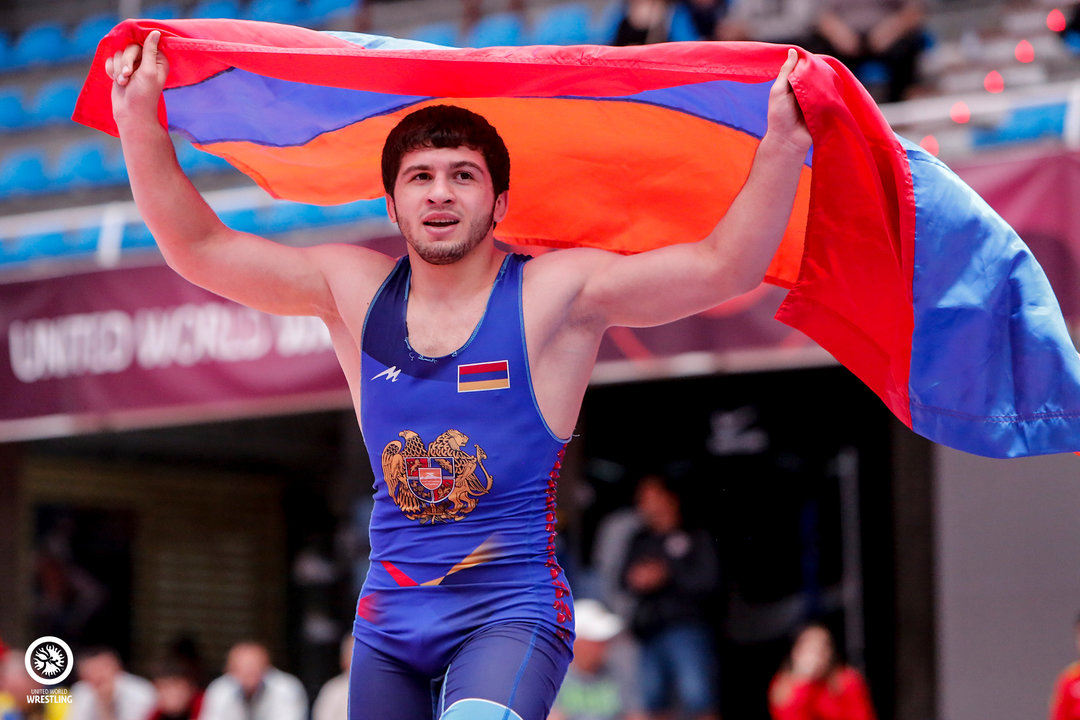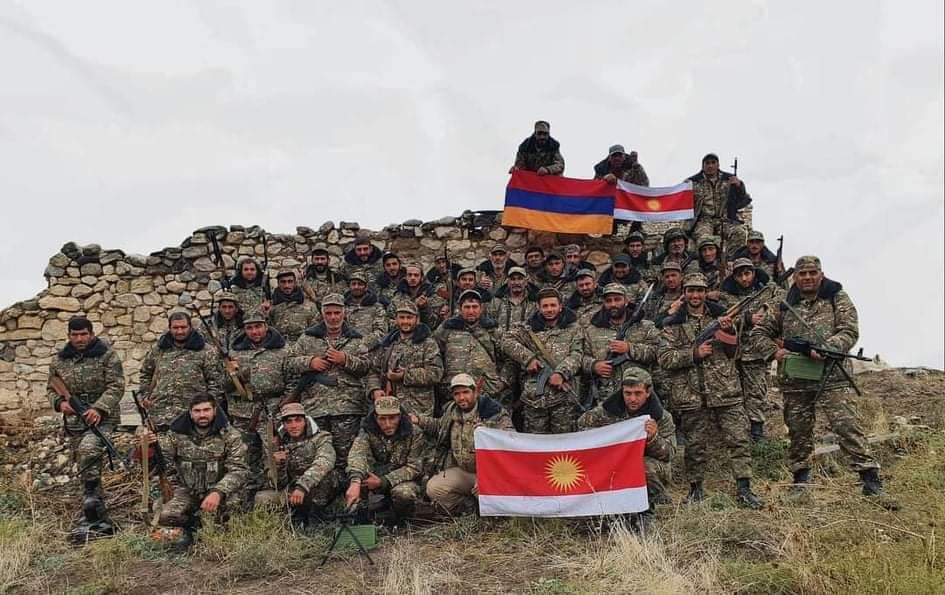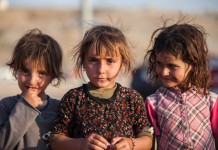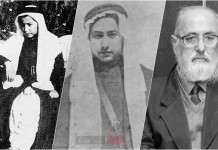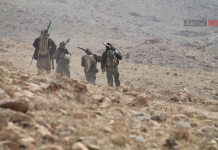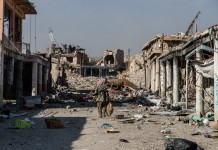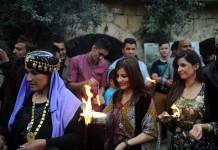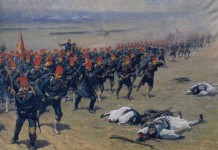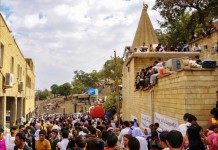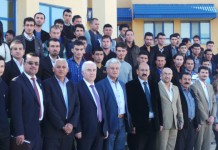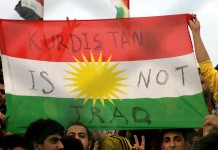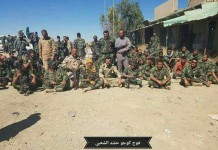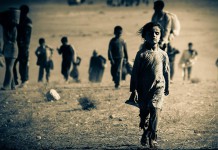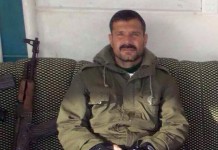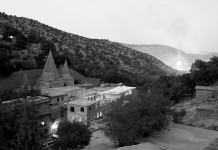Comment by Matthew Barber
This article was published May 30, 2017 by NRT, a media service in Iraqi Kurdistan. The original article is available here. Photos and Images have been added to the re-post on Syria Comment that were not present in the original.

Sinjar is at a pivotal moment of transition and the next phase of its future will likely be determined by what happens over the next few weeks. This environment of change offers the US, UN, and EU a significant opportunity to help resolve the political crisis in Sinjar, and some specific recommendations for action will be detailed in this article.
Background on the Yazidi Hashd
Observers who have followed events in Sinjar over the past few years have probably seen the KDP-PKK rift as the salient competition in the area. This dynamic is now complicated by the presence of a third major actor, the Hashd al-Sha’bi and their quickly growing local Yazidi battalions.
The Hashd al-Sha’bi (or Popular Mobilization Units—PMU) are mostly known as a set of Shi’i militias, but the Hashd Body (or PMU Committee – هيئة الحشد), the institutional entity under which the Hashd al-Sha’bi are administrated, also serves as an umbrella for affiliated forces among many other Iraqi communities, including Christians, Turkmen, Sunni Arabs, and Yazidis.
Initially, the Hashd Body financially supported Haider Shesho’s forces in Sinjar (from fall 2014 to April 2015), but withdrew their support after his organization mismanaged Hashd funds, and more importantly, after Haider was politically pressured and attacked by the KDP (he was arrested and held for nine days in April 2015 by the KDP asaish). After this, the Hashd began financially supporting the YBŞ, a PKK affiliate in Sinjar mainly comprised of local Yazidis. Baghdad’s interest in supporting these local Yazidi actors who were in political competition with the KDP has to do with Sinjar’s status as a disputed territory to which Baghdad and Erbil both lay administrative claims. The Hashd Body suspended financial support of the YBŞ in October 2016 around the time when the battle for Mosul began, temporarily capitulating to KDP demands in order to maintain harmony among allies in this key operation. This financial support has now resumed, with salaries for the YBŞ having been paid again this month, the first time since October. However, it is uncertain how long this support will last, as this article will question the future relevance of the YBŞ.
In addition to the Hashd Body’s financial support for these Yazidi forces in Sinjar, a Yazidi Hashd force was also created, but it could not reach Sinjar to participate in the fight against IS, because these Yazidi forces were not allowed to pass through Kurdistan. The Yazidi Hashd force was formed around a year ago by a Yazidi man from Khanasor who goes by the nickname of Khal Ali, but whose official name is Ali Serhan Eissa. (This name deviates from the common patronymic naming system, because Ali’s father’s name is Walati, but this name is not included in Ali’s official name. Walati was killed in Khanasor on Aug. 3, 2014 by IS, and his body is among those in one of Khansor’s mass graves. Khal Ali is therefore a genocide survivor who believed that a Yazidi Hashd force was the best option to provide security to Sinjar.) The initial Hashd force created for Yazidis was called the Lalish Battalion (فوج لالش).
The recent successes in the battle for Mosul have opened up access to Sinjar without the need to pass through the Kurdistan Region. Ever since IS took the Mosul, Tal Afar, and Ba’aj areas in 2014, the KDP has enjoyed exclusive control over civilian and NGO access to Sinjar from within Iraq, a factor that has led to political problems due to the economic blockade and other measures that have prevented Yazidi IDPs from returning to their homes. This is changing as IS is being cleared out of significant portions of the Nineveh governorate, which has allowed the Yazidi Hashd forces to reach the Sinjar area.
The KDP’s Failure to Liberate Yazidi Villages South of Sinjar
Aside from the smaller farming villages around the foothills of Sinjar Mountain, Sinjar’s main population centers are Sinjar City (the largest urban area, located on the south side of the mountain), and lines of large Yazidi towns on both the north and south sides of the mountain (called “collective villages”). All areas to the north of the mountain were cleared of IS in December 2014. In November 2015, the KDP Peshmerga led an operation to retake Sinjar City. PKK forces and their affiliates, not strong enough to retake the city on their own and without the US air support that accompanied the Peshmerga operation, joined in the brief campaign, which many Peshmerga commanders described to Western reporters as “easy” or performed with “little resistance.” Upon the completion of this operation, the Peshmerga did not establish the front line far enough south to place the city beyond shelling range; IS therefore continued to shell the city (beginning to use chemical weapons around February 2016), which resulted in ongoing injury to Yazidi Peshmerga and prevented the return of civilian life to the city. More important than the city (which is almost entirely destroyed) are the southern collective villages, where most of the Yazidi population of the mountain’s south side lived. Fearing that a large-scale return of Yazidi civilians could further degrade KDP influence in the area (while the PKK remains a very present competitor) and preclude the chance for the KDP to regain total control, the KDP has not moved forward on the liberation of the southern collectives and the Peshmerga have sat idle on the front line for a year and a half. Despite official rhetoric on “reclaiming Sinjar for the Yazidi people,” from November 2015 to the present, all of the Yazidi towns south of Sinjar have remained under IS control, even though in many cases these towns have been guarded by a minimal IS presence, and in all cases a presence far less significant than had been the case in Sinjar City. This, combined with the economic blockade designed to prevent Yazidi civilians from returning from the camps to their homes on the north side, even further exacerbated the sense of victimization that the Yazidis felt vis-à-vis the KDP.
These policies have contributed to significant frustrations among the Yazidi Peshmerga, who have not been equipped with the weaponry necessary to liberate their own villages—lying just a few kilometers away—and has produced the conditions favorable for the shift of support toward the Hashd al-Sha’bi, which is underway now.
The Current Hashd al-Sha’bi Operation in the Sinjar Region
On May 12, the Yazidi Hashd began operations on the south side of Sinjar Mountain. They began in the Tal Banat (southeastern most Yazidi collective village) and Nahiya Blej (Arab-majority subdistrict) areas. (This has been part of a larger operation to liberate the entire area from Qayrawan to Ba’aj.)
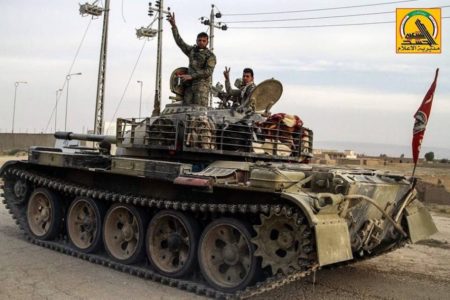
When this operation began, Yazidis begged the Peshmerga leadership to give the order to cooperate with the Hashd and join the effort to liberate the Yazidi towns. This request was refused, leading to great internal frustration among the Yazidi Peshmerga who had long been promised that they would receive support to liberate their homes, but who have instead waited indefinitely.

Qasim Shesho (head of the Yazidi Peshmerga in Sinjar) has had 14 battalions under his command. On May 15, Naif Jasso, for whom one of the battalions was named, and his son Talib who commanded the battalion (which was stationed in the vicinity of the cement factory, several kilometers east of Sinjar City), left the Peshmerga with the men under their command and joined the Yazidi Hashd. Naif is from Kocho, the southernmost Yazidi town on the mountain’s south side, which was the site of the Kocho Massacre (Aug. 15, 2014), probably the single worst massacre of the larger Yazidi Genocide. Naif is the brother of Kocho’s mukhtar, Ahmed Jasso, who was killed along with the other teen and adult males of the town, in the massacre. (Naif was outside of Kocho when the massacre was conducted.) Naif and Talib had served in the Yazidi Peshmerga in Sinjar for about two years before dissociating from it.
From the 15th on, these former Peshmerga participated with the rest of the Yazidi Hashd in retaking Yazidi areas. Other Yazidi Peshmerga also left their units and joined the Yazidi Hashd, whose ranks quickly expanded by the hundreds. To accommodate this rapid influx of new recruits, a second battalion of Yazidi Hashd was created to function alongside the Lalish Battalion; the second force is called the Kocho Battalion (فوج كوچو) and is commanded by Naif Jasso.
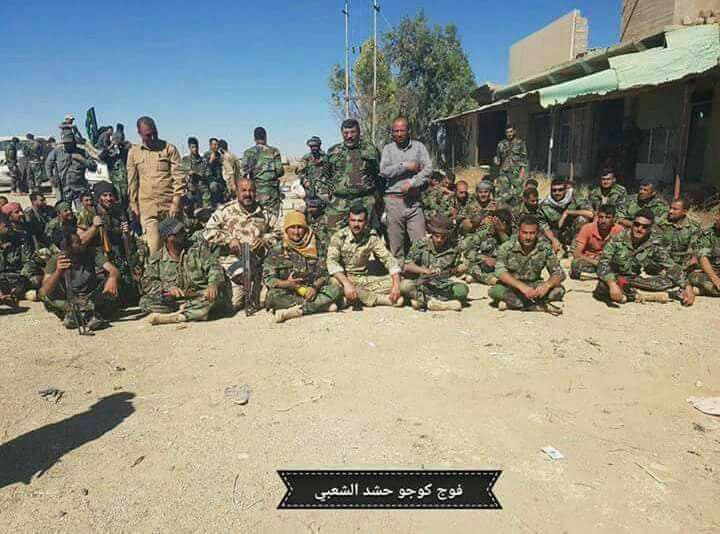
The Hashd in Sinjar (the two Yazidi battalions along with Shi’i Hashd al-Sha’bi) first liberated some of the Arab villages from IS control, and by the 21st they had fully liberated the Yazidi towns of Tal Banat and Tal Qasab. On May 25th, Kocho was liberated. On the 28th, Elias Tala’, a Yazidi Peshmerga company commander left the Peshmerga with his men and joined the Yazidi Hashd. By May 29th, all of the remaining large Yazidi collectives (Ger Zerik, Tal Ezeir, Siba Sheikh Khidr) were under Hashd al-Sha’bi control and the Hashd forces completed the total elimination of the IS presence in the Sinjar Region.

The KDP Response: Propaganda and Arrests
As soon as the Hashd al-Sha’bi began liberating Yazidi villages, KDP officials and KDP media articles began to condemn the Hashd, demanding their withdrawal, and saying that “only the Peshmerga forces should liberate the remaining areas” or accusing Baghdad of “ignoring Article 140,” referring to the Iraq Constitution’s article about the resolution of disputed territories. It is brazen and even quite comical for Kurdish officials to invoke Article 140, considering the degree to which Peshmerga militias have unilaterally seized many disputes territories in Iraq, including Sinjar itself. Kurdish officials have also claimed that Baghdad is violating an agreement with the KRG, in which Baghdad had said that its forces “would not enter Kurdish areas.” Ironically, this position makes the KDP culpable for not liberating the Yazidi collectives sooner, as it places the onus of responsibility on KDP forces.
In a period of just over two weeks, the Hashd forces did more than the KDP Peshmerga had accomplished in a year and a half. Of course, the KDP is not happy amid their increasing inability to maintain the loyalty of their own troops, whom they have not helped to reclaim their towns.
During the week of May 14, Sarbast Lazgin, Massoud Barzani’s envoy in Sinjar, held a meeting with Peshmerga commanders and other local officials, ordering them to deal severely with any Yazidi from among their troops or tribes who supported or joined the Yazidi Hashd. Yazidis who were present in the meeting report that they were told to forcibly expel from Sinjar the families of anyone who joined the Yazidi Hashd. During the meeting, the KDP authorities said, “Anyone who joins the Hashd al-Sha’bi can leave Shingal and Kurdistan and move to Karbala or Najaf.”
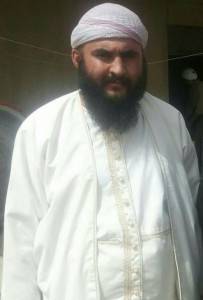
To try to prevent Yazidis from joining the Yazidi Hashd, the KDP began blocking all movement into the areas south of the mountain. In effect, they were preventing Yazidis from going to liberate their own villages. During the beginning of the operation, those desiring to join the Yazidi Hashd had to travel to the Kurdistan Region, then to Baghdad, then through liberated Mosul, and then finally to the Tal Banat/Tal Qasab areas. Despite these measures intended to prevent Yazidis from joining the ranks of the Hashd just a few kilometers away, many were willing to travel through the entire country to participate in the fight for their homes, and the ranks of the Hashd swelled by the hundreds from the outset. A number of Peshmerga also began to leave their posts during their shifts, weapons in hand, to join the Hashd. Some of these were apprehended and arrested as they tried to desert.
But in addition to the arrests of those trying to leave Peshmerga militias to join the Yazidi Hashd, on May 24, KDP asaish arrested a Yazidi civilian religious figure after he visited his own village, Tal Banat, newly liberated. The arrested man’s name is Fakhr Khalaf Khoudeida. He is a chilagir (چلەگر), one of a small number of Yazidis who adopt a holy, somewhat ascetic lifestyle, observing a 40-day fast each year. A possible reason for the asaish targeting him was that he met with many Hashd commanders, both Yazidi and Shi’i, including the controversial Hashd al-Sha’bi leader Abu Mahdi al-Muhandis, who participated in the operation to liberate the villages on the south side of Sinjar Mountain. Fakhr was photographed meeting with these commanders in Tal Banat, which, as a religious figure, lent an aura of legitimacy to the Hashd forces. Still, it was shocking to the Yazidi community that KDP forces would arrest a holy man who sought to boost the morale of Yazidi troops fighting IS on the front line. The episode reflects the growing insecurity that the KDP feels as they witness the popularity of political competitors who reject the KDP’s claim to administrative authority over Sinjar.
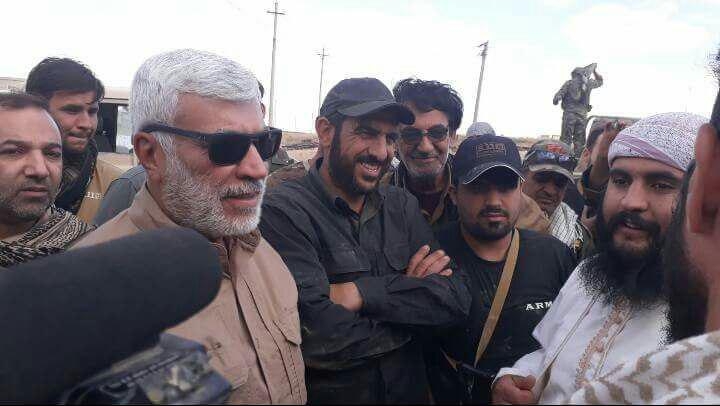
In the current situation, the KDP cannot use the argument that it directs toward PKK affiliates—that they are “foreign” forces. The Yazidi Hashd are not only comprised of local Yazidis from Sinjar, but they are an official force belonging to the central government. Nevertheless, KDP media has been describing the Yazidi Hashd as a “Shi’i force,” failing to mention the Yazidi battalions, just as they describe the YBŞ as a “foreign PKK” force and fail to mention their local Yazidi composition.
A Political Exodus
Eventually, the measures to prevent Yazidis from joining the Hashd forces broke down, as some Yazidi Peshmerga refused to enforce the order and began helping Yazidis get through to the south side of the mountain. Haider Shesho’s forces (which also belong to the Peshmerga) have lost significant numbers of men, as well, and Peshmerga defections have continued. Some locals estimate that the total number of Yazidis who have joined the Yazidi Hashd in the past couple weeks is nearing 1,000 (this does not include the Yazidi Lalish Battalion that existed before the operation).
The widespread readiness of many Yazidis to dissociate from the Peshmerga and join these Baghdad-affiliated forces is driven by growing dissatisfaction exacerbated by a number of factors:
– The families of these Yazidi Peshmerga are now nearing three full years in the camps with their lives on pause;
– For over a year they were prevented by the economic blockade from returning and rebuilding on Sinjar’s north side;
– The Kurdish Peshmerga Rojava now besiege the YBŞ, the main defender of Sinjar against IS, also harming the return of civilian life to Snune and Khanasor; and
– The KDP assisted Turkey in bombing the bases of PKK-affiliated Yazidis in Sinjar who have been at the front line with IS for almost three years.
This behavior was topped off by the refusal to allow the Yazidi Peshmerga to participate with the Yazidi Hashd in an operation to free their own towns—towns that the Yazidis have desperately waited to liberate. The KDP is finding itself on the wrong side of history in this development, as its policy pattern inadvertently produces the perception among many Yazidis that it actively works to thwart the fight against IS. More Yazidis are joining the Hashd every day, and though it is too soon to tell how far-reaching this trend will be, we could eventually witness at least a partial collapse of the KDP Peshmerga in Sinjar.
The Effect of the Hashd Presence on the Future of PKK Influence in Sinjar

Most observers immediately assume that the new presence of the Hashd al-Sha’bi in Sinjar will be a boon to the local PKK affiliates. The YBŞ has been besieged by the Peshmerga Rojava for nearly three months, with its movements restricted and its fighters harassed by KDP asaish. Baghdad’s financial support for the YBŞ (resumed this month) and the new presence of a military competitor with the KDP would intuitively indicate an upswing in the fortunes of PKK affiliates. But in fact, the presence of this new “ally” will more likely spell the decline of PKK influence in Sinjar. Even if the presence of the Hashd alleviates some of the pressure facing the YBŞ, giving it a longer lifespan than would be the case if it had no support against KDP forces and Turkey, the relevance of the group over the long run may wane.
As I have written previously, Yazidis have hoped that the PKK role in Sinjar would be temporary. Most did not buy into the PKK’s larger ideological message but hoped that the PKK would act as a bulwark, preventing the KDP from regaining hegemony until the Yazidis could create a framework of self-administration. Many Yazidis have been wary of exchanging one form of single-party Kurdish rule for another, but joined the YBŞ and its related civil administrative entities (such as the “Self-Administrative Council”) hoping to resist the KDP’s attempts to restore its dominance until a new opportunity presented itself for the creation of a more autonomous form of local governance. In a sense, they have succeeded in this.

As soon as the Hashd al-Sha’bi arrived on the scene, a crisis began inside the YBŞ. Yazidis are not only deserting the Peshmerga—the YBŞ is also losing many fighters who are flocking to join the Yazidi Hashd. Though Yazidis do not blame the YBŞ for not liberating the southern collectives the way they blame the Peshmerga (they know that the YBŞ have not been capable of doing it alone and yet have been highly active on the front line), other frustrations have led to a gradual increase of tensions with the PKK leadership.
Many fighters have been frustrated at the ineffectiveness of the YBŞ in countering the Peshmerga Rojava’s endeavor to thwart their mobility. The local Yazidis in the YBŞ are frustrated with the PKK leadership for not taking a tougher stance on Peshmerga expansionism in the mountain. But beyond these more circumstantial challenges, the biggest mistake of the PKK has been its inflexibility in pushing its ideological agenda, which is in many ways culturally foreign to Sinjar’s Yazidis. The Yazidis who have joined the PKK-affiliates and helped lead the Self-Administrative Council have repeatedly asked the PKK to empower them to create a more locally-specific system rather than one that has to mirror PKK institutions elsewhere. But as a former Council member confided in me, “What they promise and what they do are different.” Council members also feel that the PKK is not transparent with the Yazidi leaders about its own political agendas, which may not completely align with the goals of the local community. Though in word, the PKK always conveys receptiveness regarding Yazidi aspirations, many Yazidis feel that instead of delivering on these overtures, the PKK ultimately wants the YBŞ to be an extension of the PKK in Sinjar rather than giving it the freedom to be a locally distinct entity that is also part of Iraq.
Senior members of the Council are therefore leaving it, at the same time that many YBŞ fighters are leaving the YBŞ and joining the Yazidi Hashd. The changing affiliation of the fighters is being prompted by both the successes of the Hashd al-Sha’bi and the frustrations with the PKK leadership. An exodus is underway from both the military and civilian organizations affiliated with the PKK in Sinjar.
This could be the beginning of the end of the PKK in Sinjar.
The Misconception of PKK–Hashd al-Sha’bi Alignment in Sinjar

After Turkey bombed YBŞ and PKK positions in Sinjar, several media outlets reported that the PKK and its affiliates were beginning to fly Iraqi flags, as a way to assert that these forces and parties were part of Iraq and that by bombing them, Turkey was attacking Baghdad.
These reports were exaggerated; very few Iraqi flags were raised, and only by a few local institutions. The YBŞ and other PKK-affiliated militias did not adopt the Iraqi flag.
When, on March 27, the YBŞ began attacking IS from the west in the Siba Sheikh Khider area (as Hashd forces attacked from the east), the Hashd asked the YBŞ to halt their advance. One of the main disputes was reportedly that the YBŞ were not flying the Iraqi flag. A meeting occurred the morning of May 28 between YBŞ and Hashd leaders; the substance of the meeting is unknown, but afterwards the participation of the YBŞ in the Siba area resumed.
Though there has been a tacit alliance between Baghdad and the PKK affiliates in Sinjar (primarily in the absence of Baghdad forces proper), it is now evident that the relationship between the Hashd al-Sha’bi and the PKK will be uneasy. On May 28, Qasim Shevan (the commander of a nonpartisan force of local Yazidis who stayed to defend Sinjar after the genocide, who has remained active yet unaffiliated up to the present) declared his intention to join the Yazidi Hashd. He and his men attempted to travel around the western end of the mountain (from Khanasor through Bara where they would then be able to come eastward along the highway to join the Hashd), but at Bara, the PKK did not allow them to pass. The next day, May 29, fighters affiliated with “Ezidi House,” a Yazidi political organization that advocates keeping Sinjar under Baghdad administration, also decided to join the Yazidi Hashd, but were likewise halted at Bara by the PKK. This move would not have been at all surprising coming from the KDP, but was unexpected from the PKK and illustrates the fact that all three players have distinct agendas. (It is interesting that these groups were not stopped in Khanasor by the Peshmerga Rojava—perhaps the KDP feels that it can no longer stem the tide now amid the massive momentum.)
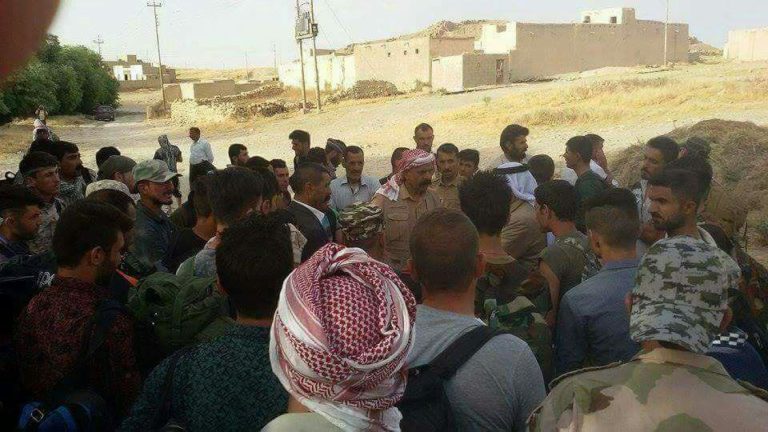
Here it should be pointed at that PKK personnel in Bara, and not Yazidi YBŞ, blocked the passage of these independent fighters traveling to Hashd-controlled territory. Yazidis on their own would not perform such a maneuver, but the PKK tries to guide the YBŞ into following its agenda. This was a fairly deliberate act against Hashd interests. What it underscores is the fact that despite the conflict between the PKK and KDP, both Kurdish groups see the entry of central government forces as a threat to their respective agendas in the area, and like the KDP, the PKK does not want to see large numbers of Yazidis join the Yazidi Hashd. (On May 30, the PKK finally lifted its blockade at Bara, and hundreds of new men immediately joined ranks with the Yazidi Hashd.)
One reason why the Self-Administrative Council has lost members is due to a frustration with the PKK on the issue of working with Baghdad, in particular. The majority of Sinjari Yazidis see the administration of the central government as providing a greater opportunity for local Yazidi governance in Sinjar, in contrast to affiliation with the Kurdistan Region which would never provide the opportunity for local administration separate from KDP control. The YBŞ and the Council, as local entities, have frequently tried to develop a relationship with Baghdad, but feel that the PKK has quietly worked to undermine this. As YBŞ insiders report, the essential PKK message is: “Sinjar is not part of Iraq and you are not part of the Iraqi forces.” That this attitude characterizes the PKK approach to Sinjar explains why there was little coordination between the YBŞ and the Hashd al-Sha’bi when the operation south of the mountain began this month.

Consistent with this, although some photos of a few YBŞ fighters standing with Shi’i Hashd al-Sha’bi forces were circulated on the 29th, claims of “cooperation” between the two groups are exaggerated. YBŞ forces came to support the fight for Siba Sheikh Khider in the general area outside the town, but their involvement was tenuous and the Hashd al-Sha’bi ended up preventing the YBŞ from entering the town. After the issue on the 27th-28th regarding the use of the Iraqi flag, the Shi’i Hashd al-Sha’bi commanders on the 29th expressed their objection to the participation of the female fighters of the YJŞ (female counterpart to YBŞ) on religious grounds. After then noting the presence of PKK guerrillas accompanying the YBŞ forces, the commanders decided not to allow any YBŞ forces to accompany the Hashd al-Sha’bi into the town.
If the Hashd forces develop a permanent presence in Sinjar, Baghdad may begin to see the PKK affiliates as superfluous. The PKK presence may also be seen by Baghdad as a risk in that it could provide Turkey with a pretext for ground intervention, however unjustified such action would be.
Sinjar—A Part of Iraq?
Sinjar has always officially been part of Nineveh administration and the central government has always provided the budget for almost all of Sinjar’s services and infrastructure. Since 2003, however, the KDP has used strong-arm tactics to push out non-KDP affiliated administrators, giving its own loyalists complete control over a budget that does not originate with the KRI. Ask almost any Sinjari Yazidi—in private—what they think of the KDP-appointed Yazidi officials in Sinjar and prepare for an earful of derision. Officials such as the token “mayor” of Sinjar can legitimately speak for very few Yazidis.
Referring to disputed territories, a recent Rudaw article made the claim that “most of the local population is expected to vote for full integration into the Kurdistan Region.” In regards to Sinjar, the opposite is true. Ask Sinjari Yazidi IDPs in the camps—or those families who have returned to Sinjar—in private whether they prefer to see Sinjar remain under Baghdad administration or become an official part of the Kurdistan Region, and most everyone will declare a preference for Baghdad. This is not the expression of a special affinity for Baghdad, or even a rejection of the Yazidi homelands as part of a “greater historical Kurdistan.” Rather, it is about the fact that central administration provides an opportunity for governance in Sinjar to bear a more local character in which Yazidis will be able to manage their own affairs and security without external pressure and cooptation. This preference is not a wholesale rejection of the KRG as much as an acute awareness of the fact that Erbil’s authority over Sinjar will inescapably mean KDP rule. Overtures of “Yazidi self-administration within the KRG” are misleading and meaningless.
Baghdad is competing with the KRG for administration in many areas of Iraq. Sinjar—the site of a recent genocide—needs to be dealt with separately from other areas. Whereas Kurdistan may have legitimate claims to certain disputed areas, Sinjar is a Yazidi homeland where the majority of the population maintains a preference for local administration rather than inclusion in the KRI.
Despite this talk about referendums, we will never see the KDP push for a referendum on Sinjar because they know that the local people will not support KDP administration there. Regardless of the KDP’s ceaseless claims to this disputed territory, they cannot overcome the simple fact that the local majority prefers to work with the central government.
An Iraqi Yazidi Solution
In October 2014, I joined a delegation of Yazidis to Washington that included tribal leaders from Sinjar. In the White House, we met with Deputy National Security Advisor Ben Rhodes who worked closely with President Obama to define US policy in the Middle East. In the meeting, the Yazidis asked the US administration to empower them to create a local, nonpartisan security force for Sinjar. Rhodes replied that the US was willing to support a Yazidi component within a theoretical Iraqi national guard system. Unfortunately, that support never appeared and the political competition over Sinjar has only further deteriorated.
The new role of the Hashd al-Sha’bi, and of its affiliated Yazidi battalions, provides an opportunity for Western governments to help end the standoff between external Kurdish parties and enable the Yazidis to accomplish what they have consistently asked the international community for since the first day of the genocide: nonpartisan security, administration, and governance, managed by local Yazidis from Sinjar and—appropriately for a context of genocide—sponsored by the international community.
Yazidis are not calling for the kind of autonomy that the Kurdistan Region enjoys within Iraq’s federal system, but rather envision the opportunity to manage their own homeland—as part of a unified Iraq—free of the scourge of single-party rule external to Sinjar. The US and other Western governments can help hold Baghdad accountable in guaranteeing a local, Yazidi administration in Sinjar.
That so many Yazidis are now joining the Yazidi Hashd creates an opportunity to develop this local security force. The Yazidi Hashd can be transitioned into a permanent, local force in Sinjar that does not necessarily need to remain a part of the Hashd system, but could be administered by the appropriate ministry in Baghdad.
Many of the Yazidis who joined the Peshmerga in Sinjar will disclose that they only did so for a salary and do not possess any real loyalty to the KDP. As Yazidis in the KDP Peshmerga and PKK affiliates join a nonpartisan security force (just as they are now leaving their respective militias to join the Yazidi Hashd), the competition on the ground in Sinjar would be rendered irrelevant and the influence of these Kurdish parties would decrease. This would occur without an outbreak of conflict between the KDP Peshmerga and the Yazidi Hashd, as opposition to a new security order will not be significant if the ranks of Peshmerga continue to dissolve. The same will be the case for the YBŞ. We have observed a refusal among the Yazidi Peshmerga to fight any other Yazidi force, which is why the KDP instead sent the non-Yazidi Peshmerga Rojava to besiege Khanasor, backed up by additional Peshmerga from the Gergeri population of Zummar who have occupied Snune. Most Yazidis just want to live a simple life in Sinjar, and will wholeheartedly reject party politics, if a healthy alternative is provided.
Take Action Now
The PKK and its affiliates will always be deeply respected by Sinjar’s Yazidis for saving them when IS besieged Sinjar Mountain, for helping the Yazidis maintain the most effective front line resistance against IS in Sinjar thereafter, for supplying tremendous amounts of food aid to Sinjar for well over a year after August 3, 2014, and for building schools and health centers for IDPs who built their camps on top of the mountain. Nevertheless, the long-term objectives of the PKK in Sinjar are not fully compatible with what the majority of Yazidis want for their homeland: a peaceful area that avoids becoming embroiled in national and regional politics, or pressured to adopt identity definitions imposed by proponents of competing nationalisms.
The new presence in Sinjar of forces affiliated with the central government has immediately diminished the importance of both the KDP and the PKK in the area. If Yazidis continue to join the Yazidi Hashd battalions, the PKK will steadily fade in importance, even if some die-hard members who have fully embraced PKK ideology remain active. The ranks of the Yazidi KDP Peshmerga will probably continue to decline, but with the Peshmerga Rojava and KDP asaish in the area, the KDP will endeavor to forcibly maintain its presence. The international community can facilitate the transfer of authority to the new Yazidi security system while helping the KDP accept the fact that it has lost the contest for popular legitimacy in Sinjar.
KDP administration in Sinjar is spotty at best and by no means indispensable: it currently exists alongside the YBŞ-affiliated Self-Administrative Council—two civil administration systems simultaneously claiming legitimacy in Sinjar. Despite the return of several thousand families to Sinjar’s north side, the KDP has been unable or unwilling to provide much in the way of restored infrastructure or services. If the responsibility for and means to maintain security are transferred to politically-unaffiliated local leaders with good reputations among the people, the community can choose respected representatives to work with the central government in developing legitimate administration in Sinjar.
The UN, US, and a number of European governments have all recognized the Yazidi tragedy as genocide. The urgent priority, therefore, should be facilitating the return of the Yazidi people to their homeland (which is now completely free of IS) and assisting with the reconstruction of their infrastructure and homes, without the harmful presence of Kurdish militias. If the roles of PKK and Peshmerga militias are reduced, and security responsibilities are transferred to a legal, local, nonpartisan Yazidi force, a major step will be taken to end despair-driven emigration from Iraq and ensure the future survival of this minority in its homeland, in the way that they themselves are requesting.
This is an opportunity that must be seized now.

